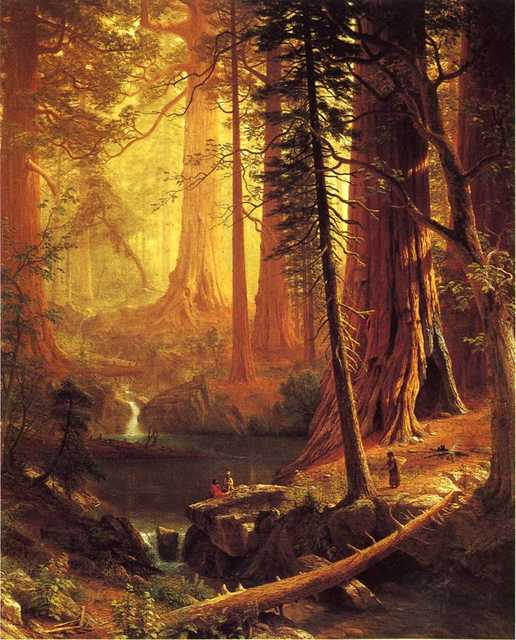
“Sunset near the Platte River (Salt Lick in Sunset Glow),” circa 1875, oil on canvas mounted to panel, 27½ by 39 inches; New Bedford Free Public Library Conservation funded by a grant from the Bank of America Art Conservation Project.
NEW BEDFORD, MASS. — Albert Bierstadt’s luminous, romantic landscapes gave Nineteenth Century America a vision of the stunning natural treasures of the Western wilderness — natural resources that would be unseen by most. For many Americans, the majestic beauty of the American West that Bierstadt painted was both revelation and inspiration. His canvases depicting these wild places were influential in shaping public opinion and helped inspire a movement to preserve these places as some of the country’s first national parks. Combining size and scale, Bierstadt portrayed the grandeur of nature that inspired preserving a nation’s natural heritage.

“Mount Sir Donald, Rocky Mountains in the Selkirk Range near the Canadian Border,” 1889, oil on canvas, 83½ by 57½ inches; New Bedford Free Public Library Conservation funded by a grant from the Bank of America Art Conservation Project.
On view through September 18 at the New Bedford Art Museum, “Bierstadt: Nature & National Identity,” curated by Janice Hodson, art curator of the New Bedford Free Public Library collection, brings together a number of works by the New Bedford native son and his contemporaries to narrate Bierstadt’s story of exploration and discovery and how it is intimately entwined with a young nation’s Western expansion and dawning awareness of a need to preserve special places for future generations.
In partnership with New Bedford Whaling National Historical Park and the New Bedford Free Public Library, the exhibition was conceived of as a way to mark the 2016 National Park Service centennial. The exhibit echoes an exhibition of art held in 1917 at the National Museum in Washington, D.C., organized by the Park Service’s first director, Stephen Mather, that shared paintings by 27 artists of scenes from various national parks. That exhibition offered people who had never journeyed out into that wild and beautiful country their first views of places that still awe visitors from around the world today.
“Bierstadt: Nature & National Identity” draws from, among other places, the City of New Bedford’s art collection held by New Bedford Free Public Library. Albert Bierstadt grew up in New Bedford and often exhibited and sold work in the area. As a consequence, a number of his works are held in local collections.
Works loaned from the library’s collection include “Sunset Light, Wind River Range of the Rocky Mountains,” depicting in the foreground an Indian encampment along a peaceful river bank with majestic snowcapped peaks rising in the background. At the time, the painting offered Americans not only a view of Western scenery but a glimpse of Native American life.

“Sunset Light, Wind River Range of the Rocky Mountains,” 1861, oil on canvas, 38 by 59 inches; New Bedford Free Public Library, gift of Eliza Nye Dana Conservation funded by a grant from the Bank of America Art Conservation Project.
Another work from the library’s collection is Bierstadt’s “Sunset near the Platte River” or “Salt Lick at Sunset Glow.” The dark silhouettes of trees are set against a vermillion and gold sunset sky. The third Bierstadt from the library is the centerpiece of the show, “Rocky Mountains in the Selkirk Range, Mount Sir Donald,” circa 1889. Although it is based on sketches done in the Canadian Rockies, at almost 7 feet in height the work is representative of the large canvases for which Bierstadt was perhaps best known. Following the artist’s travels west, the exhibit also includes “Giant Redwood Trees of California,” courtesy of the Berkshire Museum, based on sketches Bierstadt made in California.
The exhibition presents an opportunity to share two Bierstadt paintings held in private collections and rarely on view to the public. “Castel Sant’angelo (Castel St Angelo)” and “View of the Rhine” are works that have come down through a local family with a long history in the South Coast area. A third painting owned by another local family was just recently discovered to be Bierstadt’s work and will be shown in exhibition for the first time. The painting depicts Mount St Gothard, Lake Lucerne, Switzerland. A last minute addition to the show from another private collector, also never in a public exhibition, is a preliminary oil sketch done for the Lake Lucerne painting held in the collection of the National Gallery, Washington, D.C.
Partnering with New Bedford Whaling National Historical Park, there are also works and artifacts from several national park collections included in the show. “Scenery in the Grand Tetons,” by Bierstadt and held by Marsh-Billings-Rockefeller National Historical Park; albumen prints of Yosemite by Carleton Watkins from Longfellow National Historic Site and from Billings Farm; and a William Ladd Taylor watercolor from Saint-Gaudens National Historic Site are among works filling out the show’s narrative.
Hodson has gathered a wealth of additional prints, stereographs, engravings and other works of Bierstadt contemporaries to put the show in historical context and tell the story of artists’ exploration and discovery of the natural wonders of the American West. The show includes works by Thomas Cole, John James Audubon, Underwood & Underwood and Charles Bierstadt.
The New Bedford Art Museum/ArtWorks! is at 608 Pleasant Street.
For additional information, www.newbedfordart.org or 508-961-3072.










